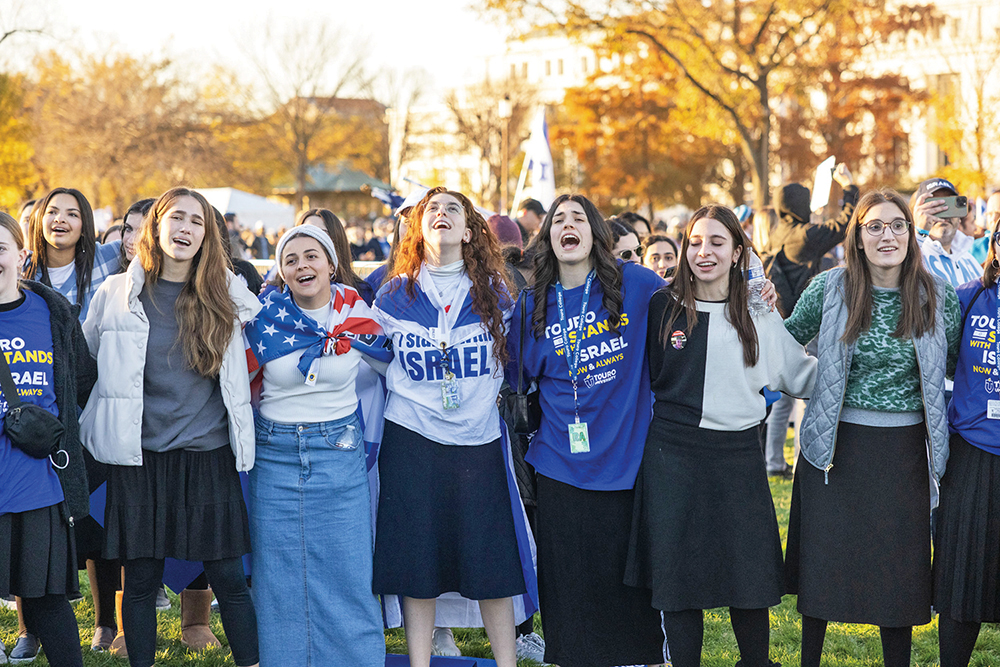
The adage that “there is strength in numbers” was borne out by the November 14 March for Israel by Jews and non-Jews who came together from all walks of life. With an almost tangible expression of unity, we stood shoulder to shoulder, 290,000 strong, on the vast lawns of the National Mall waving flags and posters. Thanks to the careful watch of government officials, we had no reason to fear for our safety and the safety of the thousands of students that came to the march from schools all over the U.S. Unlike recent anti-Israel rallies that required a massive police presence, where jeering demonstrators could turn to the dark side at any moment, in ours there was no intimidation or yelling, only caring and love. In fact, the sentiment embraced at our rally included sympathy for myriad suffering people because of the Hamas/Israel War.
As a teacher of modern history, I know that Jews as a community have a documented record of marching against injustice, whether it involves the Jewish community or not. Just one example: the 1963 March following Bloody Sunday found the Reverend Martin Luther King arm in arm with Rabbi Abraham Joshua Heschel and other Jews. Together they marched over the Edmund Pettus bridge sharing the immediate risks with other African Americans.
At the rally of November 14, even more poignant than the message from the speakers was the palpable sense of unity that resounded that day and resonated for days afterward. The residual spirit in the rally’s wake did not seem to vanish with the setting sun. In the days that followed the rally in Washington, my students experienced a surge of newfound solace and comfort. As one student said, “The knowledge and experience of being there for each other lifted us. Our pride, strength and unity were felt throughout the world.” Somehow the emotional stranglehold of the past weeks loosened just a bit, even as we continue to worry intensely for our soldiers and the hostages. Natan Sharansky expressed this so aptly when he said, “How will we get through this? By doing it together.” That, combined with the knowledge that God is our source of strength, and that the IDF with Hashem’s support will bring a victorious conclusion to this human-orchestrated devastation.
In contrast, in 1943, the Jewish community was fragmented, both from each other and from mainstream America: Four hundred Orthodox rabbis marched alone in front of the Capitol, on October 6, 1943. Three days before the holiest day on the Jewish calendar, Yom Kippur, bearded rabbis with long black coats traveled on trains and buses to the White House, under the leadership of Rabbi Eliezer Silver, head of the Vaad Hatzalah (the Orthodox Emergency Rescue Committee). These rabbis sought to meet with President Franklin D, Roosevelt, to plead for American aid to rescue the Jews of Europe from an unprovoked and deadly attack on their existence. Jews at that time were defenseless, depending entirely on the goodwill of others, which was by no means a given.
The number of marchers then may seem inconsequential. Yet, it was the only such protest in the nation’s capital during the entire war. By 1943, the Final Solution was no longer a secret and millions of Jews had already been murdered; yet until that bright autumn day, nothing was said publicly about America’s non-rescue policy.
Roosevelt himself was not interested in rescuing the Jews of Europe and did not meet with the rabbis. Instead, he snuck out of the White House through the back door and scurried off the grounds. FDR did this on the advice of his Jewish advisers who denounced the protesters. Congressman Sol Bloom (D, NY) stated that their un-American looks might actually “provoke sufficient antagonism among the citizens of the United States to cause anti-Semitic pogroms.” In a similar vein, Samuel Rosenman, FDR’s senior adviser and speechwriter remarked that “the rabbis were not representative of the most thoughtful elements in Jewry.” The most prominent American Jewish leader of the day, Rabbi Stephen Wise, publicly stated that the march was a “painful and even lamentable exhibition that offended the dignity of the Jewish people.”
So what happened on that day? Almost nothing. The petition was read by Rabbi Silver and handed over to Vice President Henry Wallace. The rabbis went back home to their communities. Their congregations prayed in unison to Hashem, over and over, to save the souls of their brethren in war-torn Europe.
Ironically, with the help of a skilled publicist, Peter Bergson, the president’s snub ended up giving the protest front-page coverage in newspapers throughout the U.S. So although the immediate result was little more than zero, the reporting of the march helped to galvanize public and congressional sympathy for rescue, which in turn boosted efforts to pressure the president to set up a government agency dedicated to rescue. Just three months later, on January 22, 1944, Executive Order 9417 established The War Refugee Board. Though chronically lacking in funds, this agency played a major role in saving the lives of over 200,000 Jews during the final year of the war.
The fragmentation of the Jewish people to pressure their leaders no doubt caused delay in the establishment of an agency devoted to rescue. The number of Jews that might have been saved could have been more. Yet, the bold actions of a handful of devout Jews made a remarkable difference. Coupled with the strong hand of God, their demonstration and efforts eventually led to the establishment of the War Refugee Board. Just think what a united front might have done if Jews had come together earlier during the Holocaust. The movement from the fragmented American Jewish community in 1943 to a united global Jewish community is a huge part of the lesson of “Never Again.”
Dr. Karen Sutton is an associate professor of history at Touro University and director of the honors program at Touro’s Lander College for Women.







